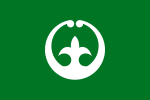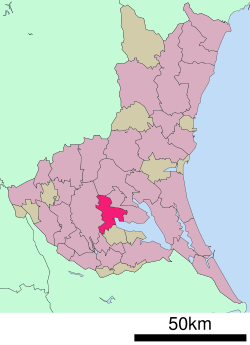Tsuchiura
Tsuchiura (土浦市, Tsuchiura-shi) is a city located in Ibaraki Prefecture, Japan. As of September 2015, the city had an estimated population of 141,181, and a population density of 1510 persons per km². Its total area is 122.89 km². About 3,000 residents are non-Japanese, a large proportion of which are Filipinos, Chinese, and Brazilians.
Tsuchiura 土浦市 | |
|---|---|
Upper: Kijo Park Middle:Tsuchiura Castle, Tsuchiura Station Lower:Skyline | |
 Flag  Seal | |
 Location of Tsuchiura in Ibaraki Prefecture | |
 Tsuchiura | |
| Coordinates: 36°4′N 140°12′E | |
| Country | Japan |
| Region | Kantō |
| Prefecture | Ibaraki Prefecture |
| Area | |
| • Total | 122.89 km2 (47.45 sq mi) |
| Population (September 2015) | |
| • Total | 141,181 |
| • Density | 1,150/km2 (3,000/sq mi) |
| Time zone | UTC+9 (Japan Standard Time) |
| - Tree | Populus, Zelkova serrata |
| - Flower | Sakura |
| - Bird | Great reed warbler, Bush warbler |
| Phone number | 029-826-1111 |
| Address | 9-1 Yamato-cho, Tsuchiura-shi, Ibaraki-ken 300-8686 |
| Website | http://www.city.tsuchiura.lg.jp/ |
Geography
Located in southwestern Ibaraki Prefecture, Tsuchiura is situated along the western shores of Lake Kasumigaura, the second largest lake in Japan. The Tokyo metropolis lies about 60 km to the south, and Tsukuba science city borders Tsuchiura to the west.
Surrounding municipalities
- Ibaraki Prefecture
History
Premodern era
Human settlement in the Tsuchiura area dates to the Japanese Paleolithic period. Hunter-gatherers inhabited the coastal area of the Pacific Ocean (now Lake Kasumigaura) forming large shell middens, examples of which can be seen at the Kamitakatsu archeological site. Locals began wet-rice cultivation and development of iron and bronze technology during the Yayoi period and in the Kofun period numerous Burial mounds were constructed in the area. During the Nara period the area was organized under the Taihō Code with what is now Tsuchiura occupying four districts of Hitachi Province. In 939, during the Heian period, Taira no Masakado lead an uprising against the central government by attacking the provincial capital at Ishioka, a few kilometers to the north of Tsuchiura. During the Kamakura period and the Sengoku period, the area was dominated by several samurai clans. During the Edo period, part of what is now Tsuchiura was administered as a castle town by Tsuchiura Domain, one of the feudal domains of the Tokugawa shogunate. The area prospered due to its position on the Mito Kaido, a highway connecting Edo with Mito and with a canal connecting Lake Kasumigaura to Edo Bay.
Modern period
With the creation of the municipalities system after the Meiji Restoration on April 1, 1889, the town of Tsuchiura was established within Ibaraki Prefecture. In 1895 railroad service was started in Tsuchiura. The Gothic Revival architecture of the old junior high school from this period can be seen at the Daiichi high school. Tsuchiura was elevated to city status when the towns of Manabe and Tsuchiura were merged on November 3, 1940. The city suffered damage during an air raid on June 10, 1945 during World War II. On September 1, 1951, Tsuchiura absorbed parts of the village of Asahi (on the shores of Arakawa) and absorbed the village of Towa. The city later absorbed the village of Kamiotsu on November 1, 1954. On February 20, 2006, the village of Niihari (from Niihari District) was merged into Tsuchiura.
Government
The city is managed by the mayor's office and the city council, essentially a mayor-council government. The mayor is elected through a citywide election and the city council are elected from their respective districts. The mayor's office is made up of the Mayor, Kiyoshi Nakagawa (中川清), and Vice mayors, Hideaki Goto (五頭英明) and Hiroshi Koizumi (小泉祐司). The 28-member city council is headed by Chairperson Kiyoshi Yaguchi (矢口清). Tsuchiura's political system is similar to other cities in Japan, as the Local Autonomy Law makes all municipalities uniform in terms of power and organization.
Economy
Education
- Tsukuba International University
- Tsuchiura has 19 elementary schools, eight public and two private middle schools, and five public and four private high schools. It also has one special education school.
Transportation
Railway
- JR East – Jōban Line
Highway
.png)



Sister city relations


Local attractions
- site of Tsuchiura Castle
- Tsuchiura National Fireworks Competition
Noted people
- Kazuhiko Nishijima, physicist
- Takeshi Terauchi, musician
- Chiaki Kuriyama, actress
- Haruma Miura, actor, singer
- Mari Iijima, singer-songwriter
- Junko Minagawa, voice actress
- Nobuo Fujita, IJN aviator
- Tomoko Fukumi, judoka
- Takayasu Akira, sumo wrestler
- Noriyuki Sugasawa, basketball player
External links
![]()
![]()
- Official Website (in Japanese)
https://www.youtube.com/watch?v=CcgrIKoTqbo and https://www.imdb.com/title/tt11779894/?ref_=ttrel_rel_tt (documentary by director Chris Jiménez)